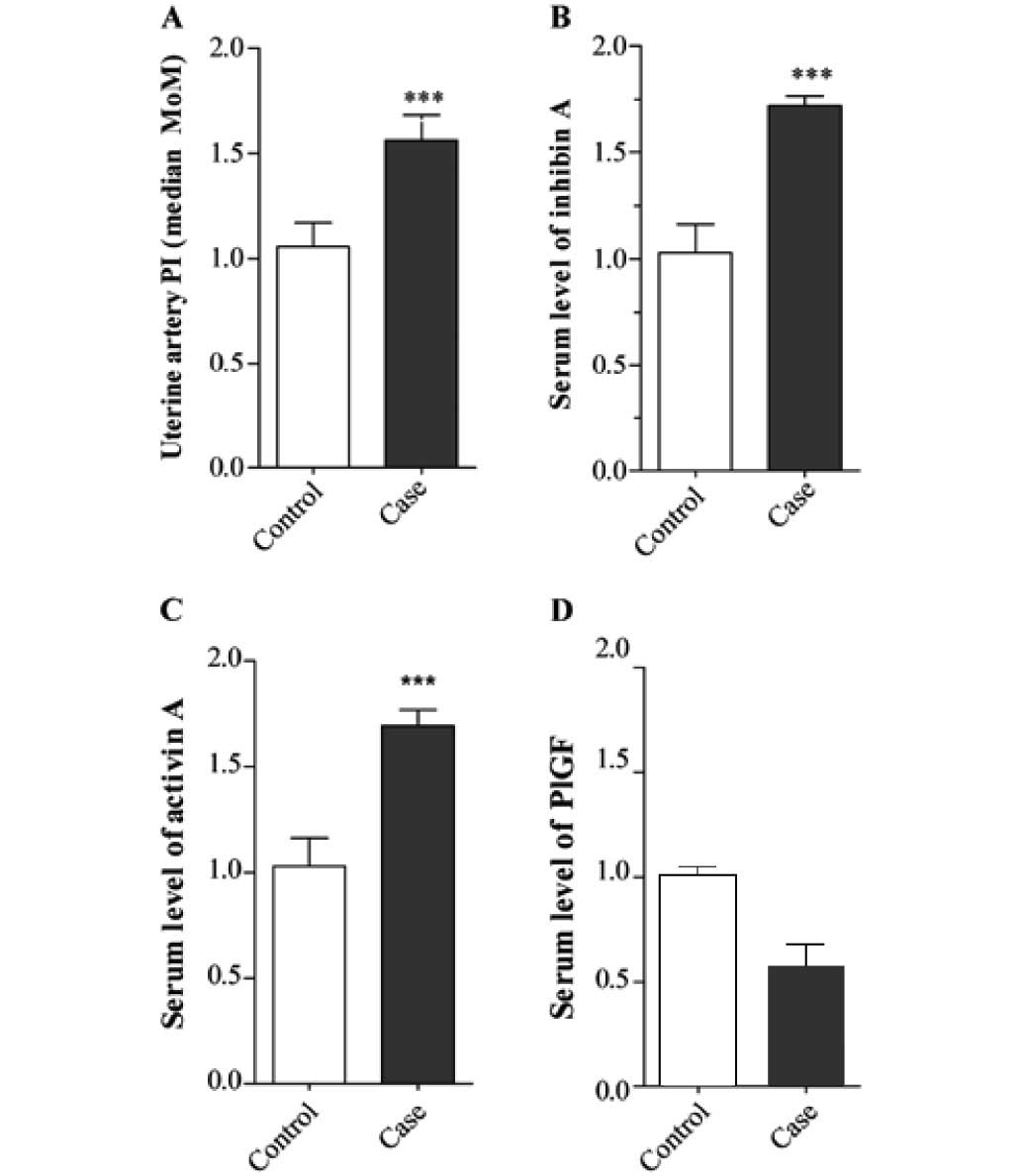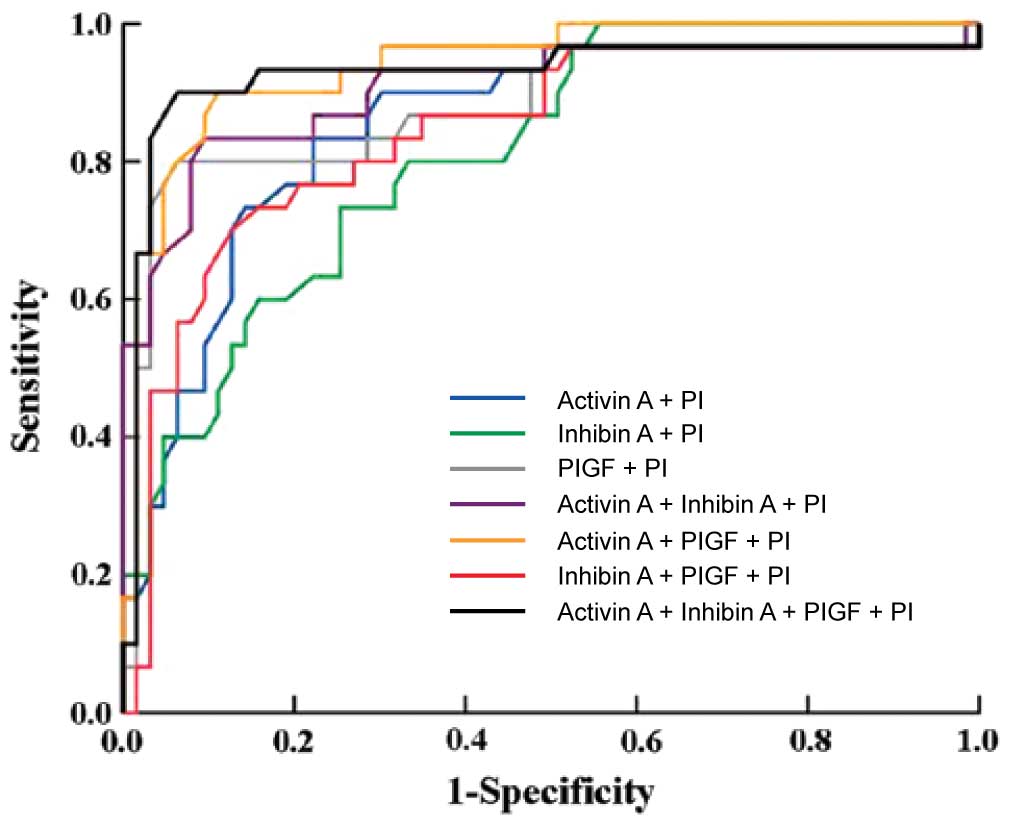|
1
|
Hodgins S: Pre-eclampsia as underlying
cause for perinatal deaths: time for action. Glob Health Sci Pract.
3:525–527. 2015. View Article : Google Scholar : PubMed/NCBI
|
|
2
|
Lim J, Cloete G, Dunsmuir DT, Payne BA,
Scheffer C, von Dadelszen P, Dumont GA and Ansermino JM: Usability
and feasibility of PIERS on the move: an mHealth App for
pre-eclampsia triage. JMIR Mhealth Uhealth. 3:e372015. View Article : Google Scholar : PubMed/NCBI
|
|
3
|
Chaiworapongsa T, Chaemsaithong P, Yeo L
and Romero R: Pre-eclampsia part 1: current understanding of its
pathophysiology. Nat Rev Nephrol. 10:466–480. 2014. View Article : Google Scholar : PubMed/NCBI
|
|
4
|
Cornelius DC and Lamarca B: TH17- and
IL-17-mediated autoantibodies and placental oxidative stress play a
role in the pathophysiology of pre-eclampsia. Minerva Ginecol.
66:243–249. 2014.PubMed/NCBI
|
|
5
|
Craici IM, Wagner SJ, Weissgerber TL,
Grande JP and Garovic VD: Advances in the pathophysiology of
pre-eclampsia and related podocyte injury. Kidney Int. 86:275–285.
2014. View Article : Google Scholar : PubMed/NCBI
|
|
6
|
Yu J, Shixia CZ, Wu Y and Duan T: Inhibin
A, activin A, placental growth factor and uterine artery Doppler
pulsatility index in the prediction of pre-eclampsia. Ultrasound
Obstet Gynecol. 37:528–533. 2011. View
Article : Google Scholar : PubMed/NCBI
|
|
7
|
Ghosh SK, Raheja S, Tuli A, Raghunandan C
and Agarwal S: Is serum placental growth factor more effective as a
biomarker in predicting early onset preeclampsia in early second
trimester than in first trimester of pregnancy? Arch Gynecol
Obstet. 287:865–873. 2013. View Article : Google Scholar : PubMed/NCBI
|
|
8
|
Weed S, Bastek JA, Anton L, Elovitz MA,
Parry S and Srinivas SK: Examining the correlation between
placental and serum placenta growth factor in preeclampsia. Am J
Obstet Gynecol. 207:140.e1–6. 2012. View Article : Google Scholar
|
|
9
|
Woodham PC, Brittain JE, Baker AM, Long
DL, Haeri S, Camargo CA Jr, Boggess KA and Stuebe AM: Midgestation
maternal serum 25-hydroxyvitamin D level and soluble fms-like
tyrosine kinase 1/placental growth factor ratio as predictors of
severe preeclampsia. Hypertension. 58:1120–1125. 2011. View Article : Google Scholar : PubMed/NCBI
|
|
10
|
Shokry M, Bedaiwy MA, Fathalla MM,
Alsemary A, Elwakil S and Murphy A: Maternal serum placental growth
factor and soluble fms-like tyrosine kinase 1 as early predictors
of preeclampsia. Acta Obstet Gynecol Scand. 89:143–146. 2010.
View Article : Google Scholar : PubMed/NCBI
|
|
11
|
Lai J, Larroca S Garcia-Tizon, Peeva G,
Poon LC, Wright D and Nicolaides KH: Competing risks model in
screening for preeclampsia by serum placental growth factor and
soluble fms-like tyrosine kinase-1 at 30–33 weeks gestation. Fetal
Diagn Ther. 35:240–248. 2014. View Article : Google Scholar : PubMed/NCBI
|
|
12
|
Hanita O, Alia NN, Zaleha AM and Nor Azlin
MI: Serum soluble FMS-like tyrosine kinase 1 and placental growth
factor concentration as predictors of preeclampsia in high risk
pregnant women. Malays J Pathol. 36:19–26. 2014.PubMed/NCBI
|
|
13
|
Ghosh SK, Raheja S, Tuli A, Raghunandan C
and Agarwal S: Serum placental growth factor as a predictor of
early onset preeclampsia in overweight/obese pregnant women. J Am
Soc Hypertens. 7:137–148. 2013. View Article : Google Scholar : PubMed/NCBI
|
|
14
|
Odibo AO, Rada CC, Cahill AG, Goetzinger
KR, Tuuli MG, Odibo L, Macones GA and England SK: First-trimester
serum soluble fms-like tyrosine kinase-1, free vascular endothelial
growth factor, placental growth factor and uterine artery Doppler
in preeclampsia. J Perinatol. 33:670–674. 2013. View Article : Google Scholar : PubMed/NCBI
|
|
15
|
Ghosh SK, Raheja S, Tuli A, Raghunandan C
and Agarwal S: Can maternal serum placental growth factor
estimation in early second trimester predict the occurrence of
early onset preeclampsia and/or early onset intrauterine growth
restriction? A prospective cohort study. J Obstet Gynaecol Res.
39:881–890. 2013. View Article : Google Scholar : PubMed/NCBI
|
|
16
|
Demers S, Bujold E, Arenas E, Castro A and
Nicolaides KH: Prediction of recurrent preeclampsia using
first-trimester uterine artery Doppler. Am J Perinatol. 31:99–104.
2014. View Article : Google Scholar : PubMed/NCBI
|
|
17
|
Lai J, Poon LC, Pinas A, Bakalis S and
Nicolaides KH: Uterine artery Doppler at 30–33 weeks gestation in
the prediction of preeclampsia. Fetal Diagn Ther. 33:156–163. 2013.
View Article : Google Scholar : PubMed/NCBI
|
|
18
|
Kafkaslı A, Türkçüoğlu I and Turhan U:
Maternal, fetal and perinatal characteristics of preeclampsia cases
with and without abnormalities in uterine artery Doppler indexes. J
Matern Fetal Neonatal Med. 26:936–940. 2013. View Article : Google Scholar : PubMed/NCBI
|
|
19
|
Zhou A, Dekker GA, Lumbers ER, Lee SY,
Thompson SD, McCowan LM and Roberts CT: SCOPE consortium: The
association of AGTR2 polymorphisms with preeclampsia and uterine
artery bilateral notching is modulated by maternal BMI. Placenta.
34:75–81. 2013. View Article : Google Scholar : PubMed/NCBI
|
|
20
|
Llurba E, Sánchez O, Domínguez C, Soro G,
Goya M, Alijotas-Reig J and Cabero L: Smoking during pregnancy:
changes in mid-gestation angiogenic factors in women at risk of
developing preeclampsia according to uterine artery Doppler
findings. Hypertens Pregnancy. 32:50–59. 2013. View Article : Google Scholar : PubMed/NCBI
|
|
21
|
Gallo DM, Poon LC, Akolekar R, Syngelaki A
and Nicolaides KH: Prediction of preeclampsia by uterine artery
Doppler at 20–24 weeks gestation. Fetal Diagn Ther. 34:241–247.
2013. View Article : Google Scholar : PubMed/NCBI
|
|
22
|
Takahashi K, Ohkuchi A, Suzuki H, Usui R,
Kuwata T, Shirasuna K, Matsubara S and Suzuki M: Biophysical
interaction between blood pressure and uterine artery Doppler for
the occurrence of early-onset preeclampsia: a prospective cohort
study. Pregnancy Hypertens. 3:270–277. 2013.PubMed/NCBI
|
|
23
|
Goetzinger KR, Zhong Y, Cahill AG, Odibo
L, Macones GA and Odibo AO: Efficiency of first-trimester uterine
artery Doppler, a-disintegrin and metalloprotease 12,
pregnancy-associated plasma protein a, and maternal characteristics
in the prediction of preeclampsia. J Ultrasound Med. 32:1593–1600.
2013. View Article : Google Scholar : PubMed/NCBI
|
|
24
|
Weintraub AY, Aricha-Tamir B, Steiner N,
Hamou BE, Baron J and Hershkovitz R: Postpartum uterine artery
Doppler velocimetry among patients following a delivery complicated
with preeclampsia. Hypertens Pregnancy. 32:450–458. 2013.
View Article : Google Scholar : PubMed/NCBI
|
|
25
|
Diguisto C, Le Gouge A, Piver E, Giraudeau
B and Perrotin F: Second-trimester uterine artery Doppler, PlGF,
sFlt-1, sEndoglin, and lipid-related markers for predicting
preeclampsia in a high-risk population. Prenat Diagn. 33:1070–1074.
2013. View
Article : Google Scholar : PubMed/NCBI
|
|
26
|
Lehnen H, Mosblech N, Reineke T, Puchooa
A, Menke-Möllers I, Zechner U and Gembruch U: Prenatal clinical
assessment of sFlt-1 (soluble fms-like tyrosine kinase-1)/PlGF
(placental growth factor) ratio as a diagnostic tool for
preeclampsia, pregnancy-induced hypertension, and proteinuria.
Geburtshilfe Frauenheilkd. 73:440–445. 2013.(In German). View Article : Google Scholar : PubMed/NCBI
|
|
27
|
Hassan MF, Rund NM and Salama AH: An
elevated maternal plasma soluble fms-like tyrosine kinase-1 to
placental growth factor ratio at midtrimester is a useful predictor
for preeclampsia. Obstet Gynecol Int. 2013:2023462013. View Article : Google Scholar : PubMed/NCBI
|
|
28
|
Bdolah Y, Elchalal U, Natanson-Yaron S,
Yechiam H, Bdolah-Abram T, Greenfield C, Goldman-Wohl D, Milwidsky
A, Rana S, Karumanchi SA, et al: Relationship between nulliparity
and preeclampsia may be explained by altered circulating soluble
fms-like tyrosine kinase 1. Hypertens Pregnancy. 33:250–259. 2014.
View Article : Google Scholar : PubMed/NCBI
|
|
29
|
Rizos D, Eleftheriades M, Karampas G,
Rizou M, Haliassos A, Hassiakos D and Vitoratos N: Placental growth
factor and soluble fms-like tyrosine kinase-1 are useful markers
for the prediction of preeclampsia but not for small for
gestational age neonates: a longitudinal study. Eur J Obstet
Gynecol Reprod Biol. 171:225–230. 2013. View Article : Google Scholar : PubMed/NCBI
|
|
30
|
Ohkuchi A, Hirashima C, Takahashi K,
Suzuki H, Matsubara S and Suzuki M: Onset threshold of the plasma
levels of soluble fms-like tyrosine kinase 1/placental growth
factor ratio for predicting the imminent onset of preeclampsia
within 4 weeks after blood sampling at 19–31 weeks of gestation.
Hypertens Res. 36:1073–1080. 2013. View Article : Google Scholar : PubMed/NCBI
|
|
31
|
Huang QT, Wang SS, Zhang M, Huang LP, Tian
JW, Yu YH, Wang ZJ and Zhong M: Advanced oxidation protein products
enhances soluble Fms-like tyrosine kinase 1 expression in
trophoblasts: a possible link between oxidative stress and
preeclampsia. Placenta. 34:949–952. 2013. View Article : Google Scholar : PubMed/NCBI
|
|
32
|
Ben Ali Gannoun M, Bourrelly S, Raguema N,
Zitouni H, Nouvellon E, Maleh W, Chemili A Brahim, Elfeleh R,
Almawi W, Mahjoub T, et al: Placental growth factor and vascular
endothelial growth factor serum levels in Tunisian Arab women with
suspected preeclampsia. Cytokine. 79:1–6. 2016. View Article : Google Scholar : PubMed/NCBI
|
|
33
|
Moore GS, Allshouse AA, Winn VD, Galan HL
and Heyborne KD: Baseline placental growth factor levels for the
prediction of benefit from early aspirin prophylaxis for
preeclampsia prevention. Pregnancy Hypertens. 5:280–286.
2015.PubMed/NCBI
|
|
34
|
Tsiakkas A, Cazacu R, Wright A, Wright D
and Nicolaides KH: Maternal serum placental growth factor at 12,
22, 32 and 36 weeks gestation in screening for pre-eclampsia.
Ultrasound Obstet Gynecol. 47:472–477. 2016. View Article : Google Scholar : PubMed/NCBI
|
|
35
|
Roes EM, Gaytant MA, Thomas CM, Raijmakers
MT, Zusterzeel PL, Peters WH and Steegers EA: First trimester
inhibin-A concentrations and later development of preeclampsia.
Acta Obstet Gynecol Scand. 83:1172004. View Article : Google Scholar : PubMed/NCBI
|
|
36
|
Ong CY, Liao AW, Munim S, Spencer K and
Nicolaides KH: First-trimester maternal serum activin A in
pre-eclampsia and fetal growth restriction. J Matern Fetal Neonatal
Med. 15:176–180. 2004. View Article : Google Scholar : PubMed/NCBI
|
|
37
|
Taylor RN, Grimwood J, Taylor RS, McMaster
MT, Fisher SJ and North RA: Longitudinal serum concentrations of
placental growth factor: evidence for abnormal placental
angiogenesis in pathologic pregnancies. Am J Obstet Gynecol.
188:177–182. 2003. View Article : Google Scholar : PubMed/NCBI
|












